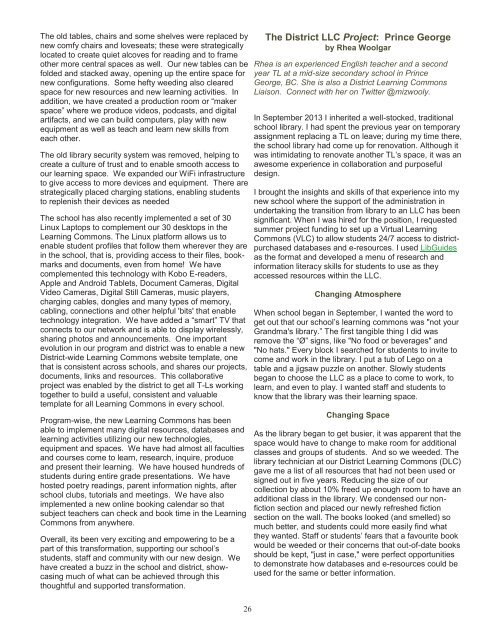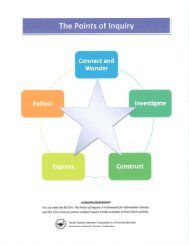FROM SCHOOL LIBRARY TO LIBRARY LEARNING COMMONS:
A source document for transforming K-12 school libraries into Library Learning Commons in BC, developed by the BC Teacher Librarians' Association
A source document for transforming K-12 school libraries into Library Learning Commons in BC, developed by the BC Teacher Librarians' Association
Create successful ePaper yourself
Turn your PDF publications into a flip-book with our unique Google optimized e-Paper software.
The old tables, chairs and some shelves were replaced by<br />
new comfy chairs and loveseats; these were strategically<br />
located to create quiet alcoves for reading and to frame<br />
other more central spaces as well. Our new tables can be<br />
folded and stacked away, opening up the entire space for<br />
new configurations. Some hefty weeding also cleared<br />
space for new resources and new learning activities. In<br />
addition, we have created a production room or “maker<br />
space” where we produce videos, podcasts, and digital<br />
artifacts, and we can build computers, play with new<br />
equipment as well as teach and learn new skills from<br />
each other.<br />
The old library security system was removed, helping to<br />
create a culture of trust and to enable smooth access to<br />
our learning space. We expanded our WiFi infrastructure<br />
to give access to more devices and equipment. There are<br />
strategically placed charging stations, enabling students<br />
to replenish their devices as needed<br />
The school has also recently implemented a set of 30<br />
Linux Laptops to complement our 30 desktops in the<br />
Learning Commons. The Linux platform allows us to<br />
enable student profiles that follow them wherever they are<br />
in the school, that is, providing access to their files, bookmarks<br />
and documents, even from home! We have<br />
complemented this technology with Kobo E-readers,<br />
Apple and Android Tablets, Document Cameras, Digital<br />
Video Cameras, Digital Still Cameras, music players,<br />
charging cables, dongles and many types of memory,<br />
cabling, connections and other helpful 'bits' that enable<br />
technology integration. We have added a “smart” TV that<br />
connects to our network and is able to display wirelessly,<br />
sharing photos and announcements. One important<br />
evolution in our program and district was to enable a new<br />
District-wide Learning Commons website template, one<br />
that is consistent across schools, and shares our projects,<br />
documents, links and resources. This collaborative<br />
project was enabled by the district to get all T-Ls working<br />
together to build a useful, consistent and valuable<br />
template for all Learning Commons in every school.<br />
Program-wise, the new Learning Commons has been<br />
able to implement many digital resources, databases and<br />
learning activities utilizing our new technologies,<br />
equipment and spaces. We have had almost all faculties<br />
and courses come to learn, research, inquire, produce<br />
and present their learning. We have housed hundreds of<br />
students during entire grade presentations. We have<br />
hosted poetry readings, parent information nights, after<br />
school clubs, tutorials and meetings. We have also<br />
implemented a new online booking calendar so that<br />
subject teachers can check and book time in the Learning<br />
Commons from anywhere.<br />
Overall, its been very exciting and empowering to be a<br />
part of this transformation, supporting our school’s<br />
students, staff and community with our new design. We<br />
have created a buzz in the school and district, showcasing<br />
much of what can be achieved through this<br />
thoughtful and supported transformation.<br />
The District LLC Project: Prince George<br />
by Rhea Woolgar<br />
Rhea is an experienced English teacher and a second<br />
year TL at a mid-size secondary school in Prince<br />
George, BC. She is also a District Learning Commons<br />
Liaison. Connect with her on Twitter @mizwooly.<br />
In September 2013 I inherited a well-stocked, traditional<br />
school library. I had spent the previous year on temporary<br />
assignment replacing a TL on leave; during my time there,<br />
the school library had come up for renovation. Although it<br />
was intimidating to renovate another TL’s space, it was an<br />
awesome experience in collaboration and purposeful<br />
design.<br />
I brought the insights and skills of that experience into my<br />
new school where the support of the administration in<br />
undertaking the transition from library to an LLC has been<br />
significant. When I was hired for the position, I requested<br />
summer project funding to set up a Virtual Learning<br />
Commons (VLC) to allow students 24/7 access to districtpurchased<br />
databases and e-resources. I used LibGuides<br />
as the format and developed a menu of research and<br />
information literacy skills for students to use as they<br />
accessed resources within the LLC.<br />
Changing Atmosphere<br />
When school began in September, I wanted the word to<br />
get out that our school’s learning commons was "not your<br />
Grandma's library.” The first tangible thing I did was<br />
remove the “Ø” signs, like "No food or beverages" and<br />
"No hats." Every block I searched for students to invite to<br />
come and work in the library. I put a tub of Lego on a<br />
table and a jigsaw puzzle on another. Slowly students<br />
began to choose the LLC as a place to come to work, to<br />
learn, and even to play. I wanted staff and students to<br />
know that the library was their learning space.<br />
Changing Space<br />
As the library began to get busier, it was apparent that the<br />
space would have to change to make room for additional<br />
classes and groups of students. And so we weeded. The<br />
library technician at our District Learning Commons (DLC)<br />
gave me a list of all resources that had not been used or<br />
signed out in five years. Reducing the size of our<br />
collection by about 10% freed up enough room to have an<br />
additional class in the library. We condensed our nonfiction<br />
section and placed our newly refreshed fiction<br />
section on the wall. The books looked (and smelled) so<br />
much better, and students could more easily find what<br />
they wanted. Staff or students’ fears that a favourite book<br />
would be weeded or their concerns that out-of-date books<br />
should be kept, "just in case," were perfect opportunities<br />
to demonstrate how databases and e-resources could be<br />
used for the same or better information.<br />
26






